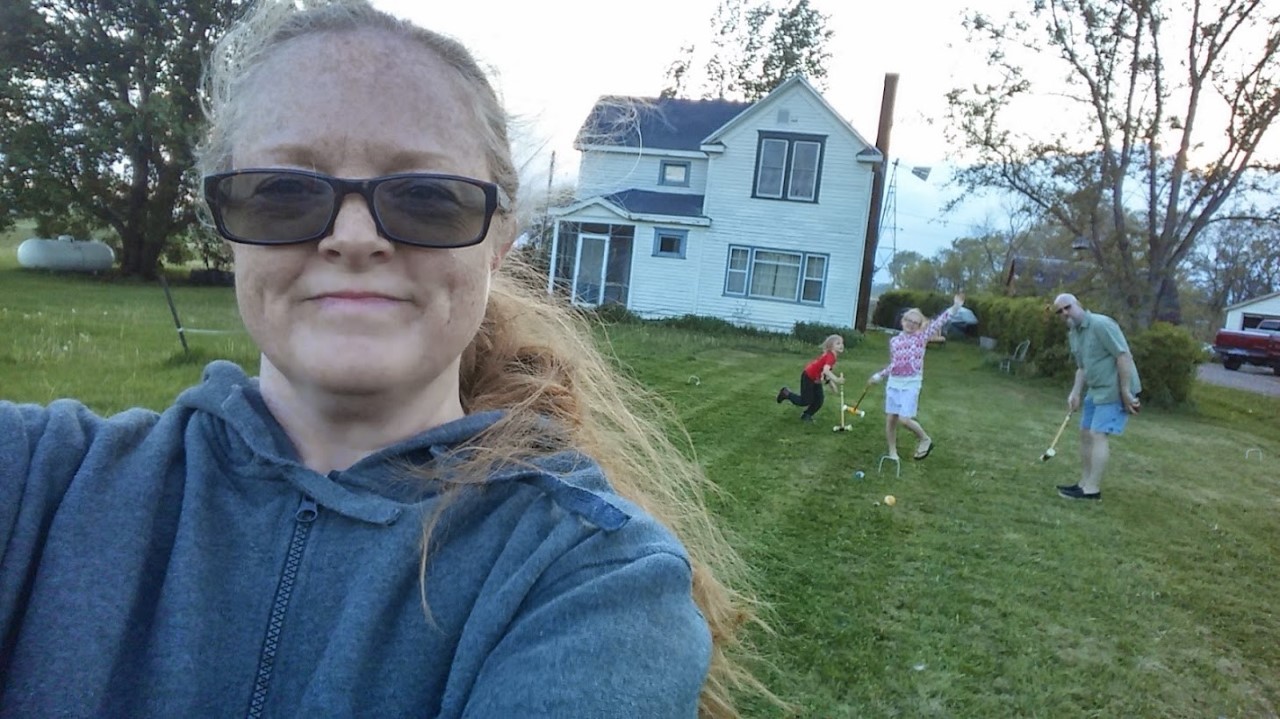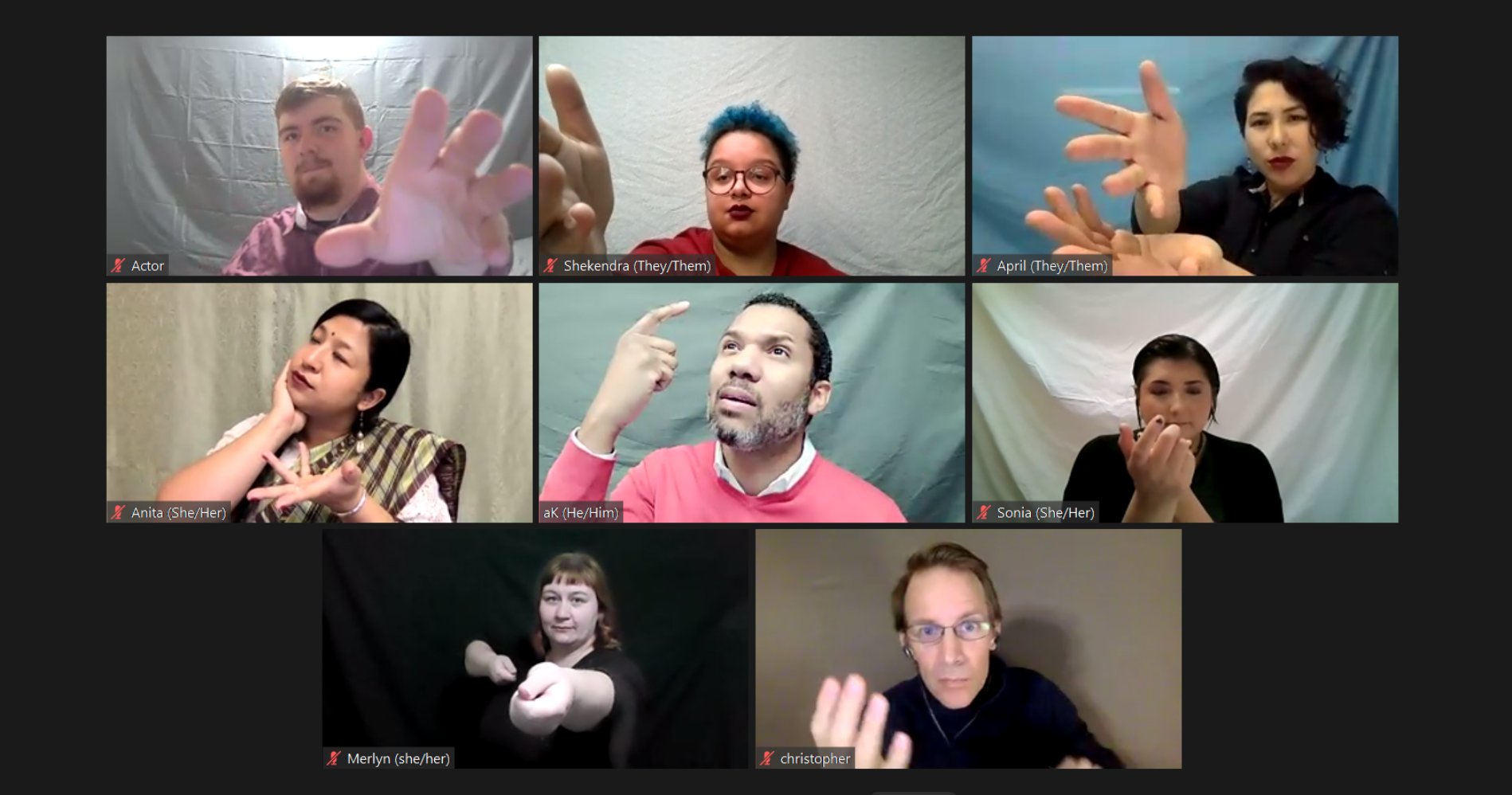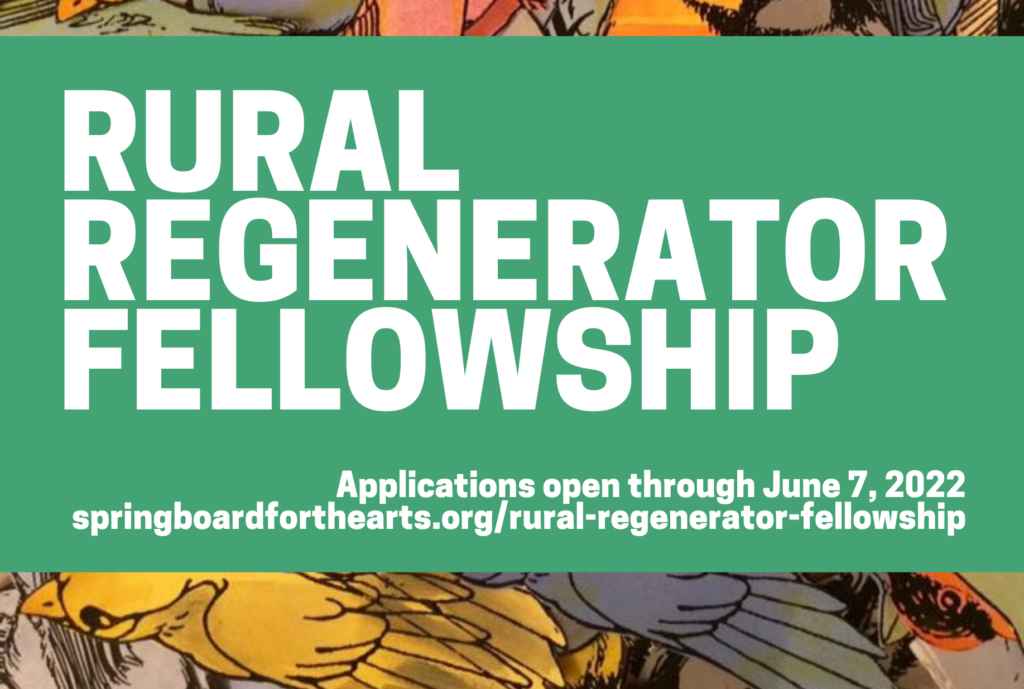Sandra Kern Mollman: Creating with Intention
The Rural Regenerator Fellowship brings together individual artists, makers, and culture bearers, grassroots organizers, community development workers, public sector workers and other rural change-makers who are committed to advancing the role of art, culture and creativity in rural development and community building. In 2022, we asked a collective of local writers to sit down with current Rural Regenerator cohort members to share more about their work.
We start my interview with Sandra Kern Mollman with some small talk and a brief introduction. I tell her I am here to talk about whatever she wants to talk about, so she should feel free to redirect our conversation at any time. Then I jump into my questions, asking how she describes herself as an artist.
Mollman pauses and looks down, a bemused smile on her face. She chuckles, smiles a little wider, and I can tell we are about to leave small talk behind. What she’s not saying in that pause is that she is more interested in stories than titles, and that the difficulty of defining her work is part of the work itself. Her work does not lend itself to the elevator pitch format.
But she’s also a kind person, so she takes pity on me, her interviewer, and launches into an explanation. “I am a musician and writer, that plus theater-maker are probably the three main roles,” she says. She goes on to explain playwriting and -making are probably what she is most grounded in and are still a passion. She has a Master’s degree in English with an emphasis in playwriting, though she shares that it wasn’t until she started teaching theater that she really connected with “why” she is so drawn to that medium.
 The story actually starts before that, she tells me, in Pierre, SD, where she first explored theater performance and production with the Pierre Players community theatre from fifth grade to her senior year. Eventually, she was asked to be one of a handful of teens charged with creating an improvisational theatre troupe called Solutions Improv. Using applied theatre techniques, Solutions Improv traveled throughout South Dakota performing in schools and engaging young kids and other teens in challenging conversations around peer pressure, family pressure, and choice making.
The story actually starts before that, she tells me, in Pierre, SD, where she first explored theater performance and production with the Pierre Players community theatre from fifth grade to her senior year. Eventually, she was asked to be one of a handful of teens charged with creating an improvisational theatre troupe called Solutions Improv. Using applied theatre techniques, Solutions Improv traveled throughout South Dakota performing in schools and engaging young kids and other teens in challenging conversations around peer pressure, family pressure, and choice making.
Upon graduation, Mollman moved to Boston to attend Berklee College of Music as a vocal performance major, but missing the imagining space of the theatre, she moved to NYC to study acting. “A lot of methodologies didn’t speak to me, until finally one did,” she says. “I had no idea how expansive it could all be until I was living it.”
This awakening began while studying with the Atlantic Theater and their Practical Aesthetics Workshop, based on “truth in the moment” and authenticity rather than on fabrication and performative presentation. For Mollman, this expression aligned with a practice of mindfulness. She found a new fascination in exploring how collective imagining spaces can lead a body to experience new truths. Eventually she began to explore activism theater and Theater of the Oppressed, theatrical forms that were first elaborated by practitioner Augusto Boal. From there her work expanded to include a diversity of other mediums, all with the common thread of being increasingly community focused and driven. She’d found her muse: bringing people together to conceptualize and then actualize a shared vision.
Recent projects include directing and producing an audience-interactive piece for Sojourn Theater that included zoomed-in actors from Vermillion, SD, Rapid City, SD, and New York City, as well as more ‘outside-the-box’ collaborations, such as the now annual Cardboard Boat Regatta, with another Rural Regenerator Fellow, Amber Hansen. But it is the creative process itself, more than anything else, that currently defines her life’s work.
Creative Innovation
“Humans are creators,” says Mollman. “It’s what we do, it’s who we are…if we learn to look at ourselves this way, if we try to create change through these processes, well, [that] is how we create the world with intention.”
Traditionally defined forms of art have been one way Mollman has been working to present these processes to her students, audiences, and fellow community members. “What it takes to make a play, for example, is the same thing it takes to make anything,” she explains. “I like to explore how we use theatre processes, exercises, and playmaking to develop the tools we need for creating real moments and relationships, rather than just for creating a play.”
 However, much of the inspiration for the direction her work has taken in the last decade came from the unexpected family decision to take her children out of school and the realization that education, like so many systems, is a construct. She follows her children’s lead on how and what they want to learn, prioritizing wholeness and discovery as a family. This experience led to living out her own theories on the creative process in real time, and it “completely changed the way I teach and work,” Mollman says. “It allowed me to see the world from the context that we really can create it however we want to.”
However, much of the inspiration for the direction her work has taken in the last decade came from the unexpected family decision to take her children out of school and the realization that education, like so many systems, is a construct. She follows her children’s lead on how and what they want to learn, prioritizing wholeness and discovery as a family. This experience led to living out her own theories on the creative process in real time, and it “completely changed the way I teach and work,” Mollman says. “It allowed me to see the world from the context that we really can create it however we want to.”
Which is how she has found herself on the cusp of an innovation that is still in the process of unfurling. “It’s still hard to describe!” She laughs. Mollman’s creative practice integrates processes of creativity with science and spirituality. She believes that when we gather with intention to imagine a more just world, investing time in play and creative explorations that embody the change we want to see, we will create that world. “Right now, I am trying to write about this way of looking at creativity because I want to find a language I can use to investigate it with other people.” Eventually she’d like to formalize this process in workshop form, a trajectory she’s already engaging in with her work as a South Dakota Humanities Scholar, as a South Dakota Artist in Schools and Communities, and as an adjunct professor at the University of South Dakota.
“The more we really listen and hear, allowing each other to show up as our whole, unique selves, the more we can create with intention,” she says. “And that energy of creation results in global change.”
Mollman believes people are ready for this conversation, she can feel a shift occurring. I happen to agree, and tell her so. Her goal is to facilitate creative spaces that can be playful and joyful and that bring positive energy to conversations and topics that can be difficult. “Yes, it’s exciting. We are in a perpetual state of discovery and expansion,” she says with a broad smile, while I nod along.
Community-Engaged Artist
In her college classes, Mollman often starts by asking: How do you identify as a creator? Most students have no idea how to answer that question and simply say they aren’t creators. After about two weeks, Mollman says a shift starts to occur, and they begin to find a path to their own creative agency. Some discover they find their creative spark in the kitchen, or in the garden, others in more traditional conceptions of ‘art.’ Mollman’s job is to help them take that spark and turn it into a flame. “We are so quick to compartmentalize art as separate from other things, but it isn’t,” she says. “So many of us spend so much time waiting for the weekend, waiting for the end of the school day or work day…and people are so uncomfortable following their own instincts,” says Mollman. Refocusing the conversation to celebrate creation, innovation, and infinite possibilities is a way to change that mentality. She believes empowering people to cultivate their own creativity empowers them to create the change they want to see in the world.
This way of working still has plenty of pitfalls. “The danger of creating toxic spaces within creative spaces is still present,” Mollman acknowledges. “It is important to me that transformational change is happening within me first. How do I stay curious, aware that, today, I understand some things incorrectly, and that I currently believe incorrect narratives? How do I use my Creator/Artist tools to remain curious – then to imagine, devise, co-create, and embody a more just world?
She sees her role as a facilitator: weaving together leadership and creativity, encouraging everyone to bring their whole selves and then nurturing that unfolding.
When asked about the Rural Regenerator Fellowship, Mollman says, “This is one of the first times I’ve applied for something and was honest about the concepts I’m really excited about – ideas versus a ‘product.’ It was kind of a wild thing to do. I wrote up my application, sent it in and thought that was that. I was so excited that they called me in based on that. It’s an encouraging place to bring these ideas.”
She also appreciates the focus on rural art and artists. “Democracy can’t happen without people understanding their possibilities as creators…and we need more opportunities for people who don’t live in an urban place to experience that.”
Like many rural artists, the advent of Zoomed workshops and conferences during COVID has been hugely beneficial for her, allowing her access that previously wasn’t possible. This fellowship has been another avenue for connection across distance, both in-person and via technology.
Mollman says she respects the fact that the Springboard staff is in a space of discovery along with the Fellows. “Because we are the first cohort,” she says, “They are getting to know us, we are getting to know them, and everyone is bringing an openness that’s really exciting.”
She also appreciates that they share resources readily, and are meeting artists where they are, with resources that are tailored to each individual. “Sounds similar to your philosophy!” I say, and then ask. “Alright, my next question: do you travel, and can you come to my town to teach a workshop?” We both laugh, even though I’m not joking. If this were a play, we’ve just dropped the fourth wall, and I realize this interview has just become exactly what her work is all about: creating community, connection, and innovation organically.

